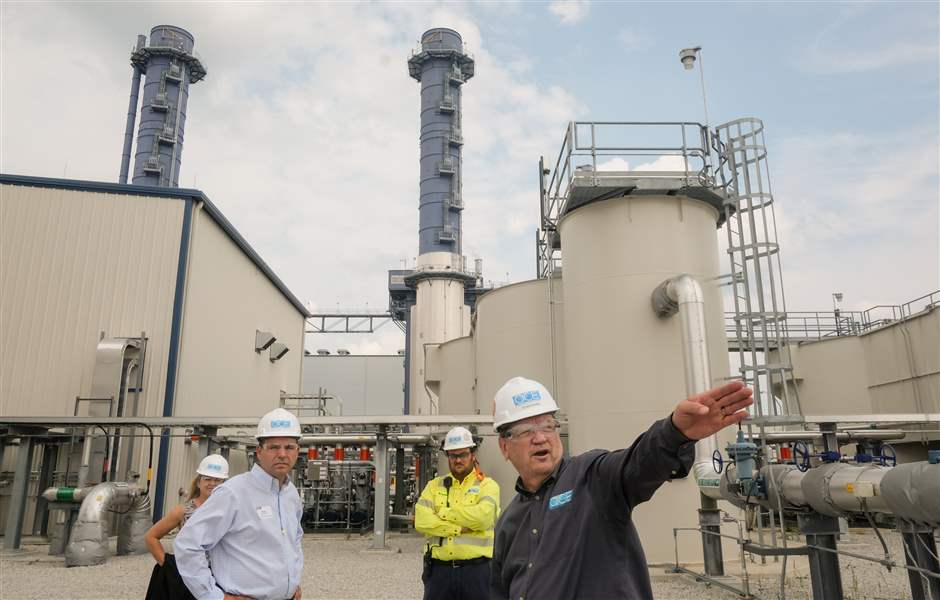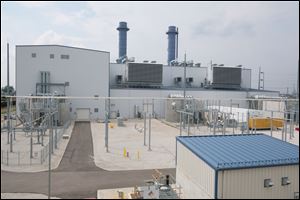
Manufacturing officials tour Oregon Clean Energy Center
8/15/2018
At right Peter Rigney, Projects General Manager, gives a tour to members of the Ohio Manufacturers Association Wednesday, August 15, 2018, at the Oregon Clean Energy Plant in Oregon.
THE BLADE/JEREMY WADSWORTH
Buy This Image
Representatives of the Ohio Manufacturers’ Association liked what they saw Wednesday when they got a tour of the Oregon Clean Energy Center located at 816 N. Lallendorf Rd., Oregon.
The combined cycle, privately-funded natural gas plant has been operating a little more than a year, going online July 1, 2017. But when it’s at full power — and Peter Rigney, Power Plant Management Services LLC’s projects general manager, says that’s pretty often — it cranks out 960 megawatts of electricity, more than the 908 megawatts produced by the FirstEnergy Solutions Davis-Besse nuclear plant about 26 miles to the east when it’s at full power.
Mr. Rigney said it also has a fraction of the nuclear plant’s overhead, with 21 employees compared to Davis-Besse’s 700. He jokingly said his entire work force is considerably smaller than just Davis-Besse’s security team.
WATCH: A look at the Oregon Clean Energy Center
Two members of the Ohio Manufacturers’ Association — Ryan Augsburger, the group’s vice president and managing director of public policy services, and Brad Belden, chairman of its energy committee — said OCE’s success is an example of how markets have shifted toward natural gas.

Exterior of the Oregon Clean Energy Plant Wednesday, August 15, 2018, in Oregon.
They also encouraged state and federal officials to build on that success, encourage others to follow suit, and not be drawn into the FES campaign for a bailout to save Davis-Besse, the company’s Perry nuclear plant east of Cleveland, its twin-reactor Beaver Valley nuclear complex west of Pittsburgh, or any of the coal-fired power plants Akron-based FirstEnergy Corp. also has turned over to FES, one of its subsidiaries.
“We’re not against nuclear power. But they have to be able to compete,” Mr. Augsburger said. “When governments start subsidizing, it’s unfair to OCE.”
Mr. Belden, who also is vice president of administrative services for Belden Brick, a Canton-based brick manufacturer, said he and other members of the Ohio Manufacturers’ Association are fighting bailouts to encourage more of the cheaper electricity prices natural gas plants have the ability to produce now that it’s being captured so affordably from Marcellus and Utica shale that is found in eastern Ohio, western and central Pennsylvania, and West Virginia.
The expanded drilling has resulted in additional pipelines being built across Ohio. The oil and gas industry has said the game-changer came a few years ago, when a horizontal technique of hydraulically fracturing, or “fracking,” that shale allowed it to gain access to previously unavailable natural gas and oil.
“We’re in the midst of a transition now because of shale gas,” Mr. Belden said, asserting that utilities have been using “scare tactics” to make people believe there isn’t enough energy being produced. PJM Interconnection, the operator of the 13-state region grid that includes Ohio, has said there is plenty of electricity being produced and that no crisis is imminent even if more nuclear and coal-fired plants close.
The two acknowledged that the Ohio Manufacturers’ Association has been an outspoken critic of attempts by FES and others to get state and federal bailouts, saying consumers would ultimately have to pay.
Some state legislatures have come to the aid of aging nuclear and coal plants, but not Ohio. President Trump announced in June he has given U.S. Energy Secretary Rick Perry a directive for a federal remedy.
“When the government starts injecting money in an unprofitable business, it deters the market from working,” Mr. Augsburger said.
Having competitors get large subsidies is akin to “bidding against a guy who has house money,” Mr. Rigney said.
Kim Bojko, Ohio Manufacturers’ Association attorney, agreed with an announcement PJM made recently to look deeper at long-term resiliency issues as the electricity markets shift more toward natural gas. The grid operator said it wants to see if there is any risk to security with more electricity being generated by plants that typically don’t store their fuel on site.
Mr. Rigney said OCE often buys its natural gas within 24 hours of usage and has it piped directly to the plant during that time. It paid $350,000 for a 24-hour supply of natural gas earlier this week, he said.
The Oregon Clean Energy Center cost about $800 million to build, one of the larger projects in Lucas County in recent years. Construction began in 2014 on a former 30-acre soybean field.
It is one of two large natural gas plants planned for that area.
In December, the Ohio Power Siting Board issued a permit to a Massachusetts developer planning to build a $900 million plant next door.
That is a 955-megawatt project undertaken by Clean Energy Future-Oregon LLC.
FES has said it will close Davis-Besse by May, 2020, and its other three nuclear plants by October, 2021, if a buyer or bailout doesn’t emerge. It reiterated its call for help on Wednesday.
Ohio’s energy landscape has changed dramatically since a decade ago, when the state got about 85 percent of its electricity from burning coal and much of the rest from nuclear plants. Ohio historically has been one of America’s most coal-reliant states.
Ohio now gets 59.8 percent of its electricity from coal, still well above the national average but much less than just a few years ago. Its percentage of electricity from natural gas now exceeds 24 percent, according to the U.S. Energy Information Administration.
The natural gas share is expected to keep rising now that 10 plants across Ohio are in various stages of planning, design, construction, or early operation.
Contact Tom Henry at thenry@theblade.com, 419-724-6079, or via Twitter @ecowriterohio.